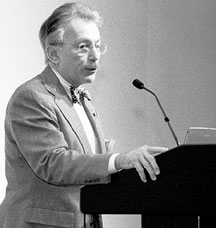|
(page 3 of 3)
Sunday
On Sunday morning, I sleep in an extra hour and catch up
with some writing and photography. In the afternoon, I go
to hear Dr. Bloom's remarks at the seminar he organized, "Neuroinformatics:
Genes to Behavior." Much of the session describes various
database projects in neuroinformatics, a field that represents
a confluence of studies in neurological and cognitive functioning
and the science of managing and mining this vast amount of
information.
In neuroinformatics, databases are employed to store large
sets of data, such as on scanned brain sections. "Brain browsers"
and other software allow researchers to access, view, and
analyze the data. Significantly, researchers in other laboratories
can access the data over the internet, and ask new questions.
Also "meta" analyses across multiple data sets can be performed
on data that would otherwise be left to gather electronic
moss.
"Information that would ordinarily reside in a laboratory's
archive [could then] be available to the public," says Bloom.
Later that day, everyone is talking about the weather. Snow
has all but shut down the East Coast. Anyone from the east
who was planning to come to the conference today will not
arrive, and anyone who was planning to leave early will be
stuck or delayed as some two feet of snow falls on every runway
from Washington to Boston.
Monday
With most of the receptions and schmoozing events over,
I decide to concentrate on attending scientific symposia and
learning lots of new things in science.
In fact, I find great joy in doing the conference equivalent
of channel surfing—going in and out of as many presentations
as I can politely manage (luckily, the doors are at the back
of the rooms and always open). I listen to a discussion of
childhood infections in England and Wales and the ecology
of infectious diseases, a description of the molecular correlates
of post-traumatic stress disorder, an analysis of tobacco
use by schizophrenics, a presentation on the structures called
neuronal spines, and a presentation that coupled cholera outbreaks
with the climate.
That evening, I attend a delightful lecture titled, "Bose-Einstein
Condensation: New Results from the Ultracold Frontier" by
Eric Cornell of the National Institute of Standards and Technology
and Carl E. Wieman of the University of Colorado. Cornell
and Wieman are the winners, along with Wolfgang Ketterle of
Germany, of the 2001 Nobel Prize in Physics for achieving
Bose-Einstein condensation—a new form of matter predicted
in the 1920s by Albert Einstein and the Indian physicist S.N.
Bose.
Looking around at the audience, which is highly populated
with what look like high school and college students, I can't
help but to wonder how many of these young minds will themselves
be inspired to study science as a career.
Tuesday
On that high note, I pack my bags—a major hour-long
effort because I forgot to leave room for all the free pens
(and I have a LOT of free pens).
Coincidentally, Dr. Bloom is taking the same plane back
to San Diego. I congratulate him on what has been a terrific
meeting. "How do you feel now that you are done?" I ask him.
"Exhausted," he says, smiling.
1 | 2 |
3

|

"Information that would ordinarily reside
in a laboratory's archive [could] be available to the public,"
says Bloom at the seminar he organized, "Neuroinformatics:
Genes to Behavior."

Nobel Laureates Eric Cornell, right,
of the National Institute of Standards and Technology and
Carl E. Wieman of the University of Colorado, left, present
a lively talk titled, "Bose-Einstein Condensation: New Results
from the Ultracold Frontier." "Evaporative cooling is the
hottest thing in cold," says Cornell.
|

